Why Hypercard Had to Die
Update: Click here if you would like to try HyperCard yourself.

Hypercard (version 2.4.1.) "Home" card.
I was a Hypercard child - though our friendship was brief.
Our seventh-grade class was led into a room full of brand-new Macintosh Performas. The day's lesson was a crash course in the use of an uncomplicated yet marvelous program. With it, one might persuade a computer to do anything and everything - or so it seemed to a child with the attention span to appreciate the wonder. Half a dozen of us were invited back a week later; and then again, and again, for several delicious months.
Among these pupils, I was the only one who had already dabbled in programming. Compared to the familiar ROM BASIC of my family's second-hand Commodore 64, the HyperTalk language seemed clunky and comically verbose. And yet there was something magical, something oddly enthralling about Hypercard as a whole. The ease with which a mostly-blank screen could be turned into an interactive, living, breathing graphical toy of my own creation was astounding, exhilarating, and addictive.
After the final week, I and one other schoolboy were driven to a distant office building, where we were asked to present our unremarkable creations in front of a darkened lecture hall. The latter was full of somber-faced, suit-wearing adults idly tapping away on costly Apple portables. With their lukewarm applause, the adventure came to its rather boring end. Lacking true English fluency at the time, I never learned exactly who was behind this brief departure from the braindead routine of my early schooling. And without regular access to a Mac (given its expense, it may as well have been a Cray as far as my family was concerned) I could not return to this fascinating plaything. My development as a programmer continued as it had begun, almost entirely Mac-less and Hypercard-less.
Though almost unknown to the sniveling digital trendoids of today, HyperCard was and is one of the most loved software products ever created. It was quite possibly an inspiration for the World Wide Web. Among its satisfied users one could even find the rich and famous.
When Steve Jobs returned from exile to rule Apple again, he let HyperCard wither away and die. Why?
In order to answer this question, it is necessary to actually power up an old Mac (or an emulator) and try HyperCard on your own skin.
Even today, there is still a wealth of HyperCard-related material on the Net, but I was unable to find a compact "Hello World"-style walkthrough example. So I created one: a very basic "four function" calculator. The materials needed for this recipe were:
- Basilisk
- A copy of HyperCard
- (Optional) A HyperTalk manual. I fished mine out of a dumpster when I was an undergraduate student.
- Around half an hour of time. Most of it was spent arranging the screenshots and writing their captions.
Without further delay:
Create a new HyperCard stack:
Now give it a name and save it:
Now you have a fresh stack, with a blank card:
Create a field:
Double-click on it and give it the title "lcd":
Re-size the field to reasonable dimensions:
Create a button:
Double-click on it and then click on the Script button in the properties dialog:
Below is the HyperTalk script that we will attach to the numeric and operator keys of our calculator. It does only one thing: append the text of the button's name - be it a number or an operator - to the calculator's "screen." The name is going to be something like card button "5". So if we want to append the number five when the "5" key is pressed, we will need to take last whitespace-delimited word of the button name -- "5" -- and perform an "eval" on it, yielding the number 5. The "value of" operator is simply the HyperTalk equivalent of Eval.
Save the button's script:
We will give each button the appropriate name:
Copy the button as many times as needed to create the calculator's numeric keys. There is no need to change the buttons' scripts, only their names.
Create the operator keys in the same way:
Now, we will need an Equals key. Create a new button:
Give it the name "=":
Now, let's give it its script. We will need to use HyperTalk's Eval again:
Now let's actually try using the calculator. Switch to HyperCard's "finger" operation:
Now enter an arithmetic expression which makes use of all four arithmetic functions, and click the "equals" key:
The result will appear:
This is a quite useless calculator without a "Clear" key. Let's add one:
The script for the "Clear" key:
There is nothing surprising about what the "Clear" key does:
We now have a very simple four-function calculator.
Having seen what you just saw, do you now know why Steve Jobs killed HyperCard?
Well, you probably don't. And I don't either. Obviously the man is dead and will tell no tales. But perhaps we can figure out the "why."
Does anyone really believe that Mr. Jobs genuinely “thought you could do everything in Cocoa and ProjectBuilder that you could do with HyperCard” ? He was far too intelligent a man to believe any such thing. One may as well say that you could do everything with a magnetized needle and a steady hand that you could do with a text editor. Or that you could do anything with Roman numerals that you could do with Arabic numerals. Or that you could do anything in INTERCAL that you could do in Common Lisp. And so forth. Jobs was almost certainly familiar with HyperCard and its capabilities. And he killed it anyway. Wouldn't you love to know why?
Here's a clue: Apple never again brought to market anything resembling HyperCard.
Despite frequent calls to do so. Despite a more-or-less guaranteed and lively market.
And I will cautiously predict that it never will again.
The reason for this is that HyperCard is an echo of a different world. One where the distinction between the "use" and "programming" of a computer has been weakened and awaits near-total erasure. A world where the personal computer is a mind-amplifier, and not merely an expensive video telephone. A world in which Apple's walled garden aesthetic has no place.
What you may not know is that Steve Jobs killed far greater things than HyperCard. He was almost certainly behind the death of SK8. And the Lisp Machine version of the Newton. And we may never learn what else. And Mr. Jobs had a perfectly logical reason to prune the Apple tree thus. He returned the company to its original vision: the personal computer as a consumer appliance, a black box enforcing a very traditional relationship between the vendor and the purchaser.
Jobs supposedly claimed that he intended his personal computer to be a "bicycle for the mind." But what he really sold us was a (fairly comfortable) train for the mind. A train which goes only where rails have been laid down, like any train, and can travel elsewhere only after rivers of sweat pour forth from armies of laborers. (Preferably in Cupertino.)
The Apple of Steve Jobs needed HyperCard-like products like the Monsanto Company needs a $100 home genetic-engineering set.
The Apple of today, lacking Steve Jobs -- probably needs a stake through the heart.
Either way, expect no HyperCard (or work-alikes) from Apple. But how about other vendors? What about open-source projects? Nothing there, either. Oh, there is no shortage of attempts. And all of them are failures for the same reason: they insist on being more capable, more complexity-laden than HyperCard. And thus, none of them can readily substitute for it.
And if you think that XCode, Python, Processing, or the shit soup of HTML/Javascript/CSS are any kind of substitute for HyperCard, then read this post again. And if you continue to think so, then you might be an autistic typical software "engineer," and please don't waste your time commenting here. Sink back into the cube farm hellpit from whence you came.
Otherwise, sit down and contemplate the fact that what has been built once could probably be built again.
Corrections and Edits:
1. Steve Jobs did not kill the Lisp Machine version of the Newton, but did kill the entire Newton project.
2. All of the comments pointing out that HyperCard was already obsolete when Steve Jobs killed it are missing the point. Jobs deliberately killed its community by refusing to maintain the product or even release the source. He could have released the source to the welcoming hands of tens of thousands of enthusiasts. All of the modern HyperCard clones (all of them substantially more complex and therefore inferior to the original) do not add up to a HyperCard community. It is an elementary "tower of Babel" situation. "Critical mass" in user communities is a well-known phenomenon. I am sure that it was not unknown to Jobs. What he truly succeeded in killing was not so much the basic concept of HyperCard but the community.
3. The various HyperCard clones and HyperCard-influenced software lack HyperCard's radical simplicity and the resulting explorability. Explorability of the "master of all you survey" variety matters. All of the extra features in a more feature-rich system like SuperCard (or even VB) are not harmless. There is a fundamental difference, especially for a child, between a system which you can fully wrap your mind around and one with countless mystery knobs.
4. Everybody pushing Javascript, Python, Wx/Qt, Cocoa, and other abominations as "HyperCard replacements" simply does not remember being a child. And/or lacks a creative bone in his body. And/or is a malicious idiot.
May 2020 Update: Seems like many readers continue to miss the essential point, just as they did in 2011. Hypercard wasn't a gem of graphic design (1-bit colour, plain line graphics) or of programming language design (one of the many laughable attempts at "natural language programming") or of high-performance number crunching... but it was simple. I.e., the entire system was fully covered by ~100 pages of printed manual. It fit in one's head. (And did not take 20 years to fit-in-head, either, an intelligent child could become "master of all he surveys" in a week or two.) Where is the printed manual for the current MS VB, or the WWW's HTML/JS/CSS/etc stack (yes including all browser warts), or for any of the other proposed "replacements" ? How many trees would have to be killed to print such a manual, and would it fit in your house? Could you read it cover to cover, or would you die of old age first?

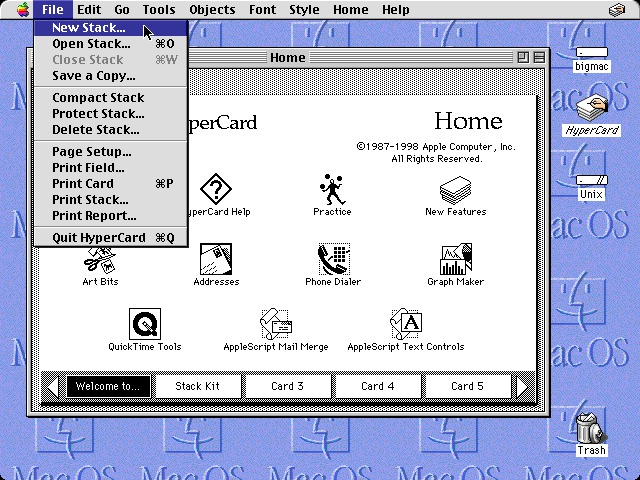
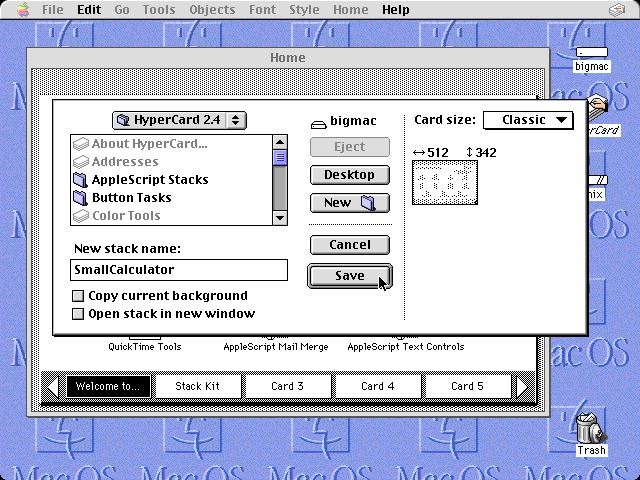
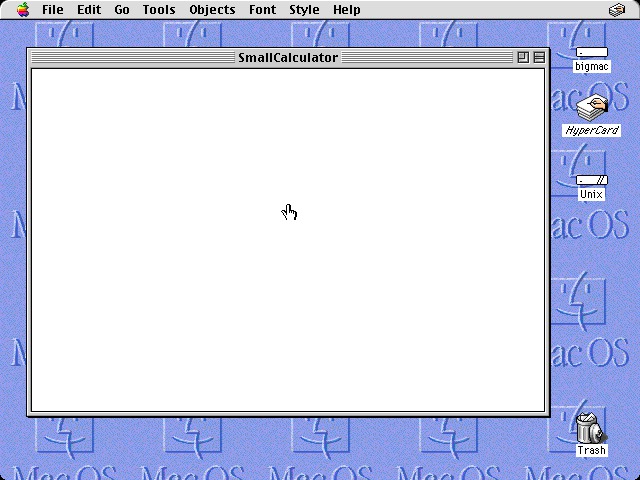
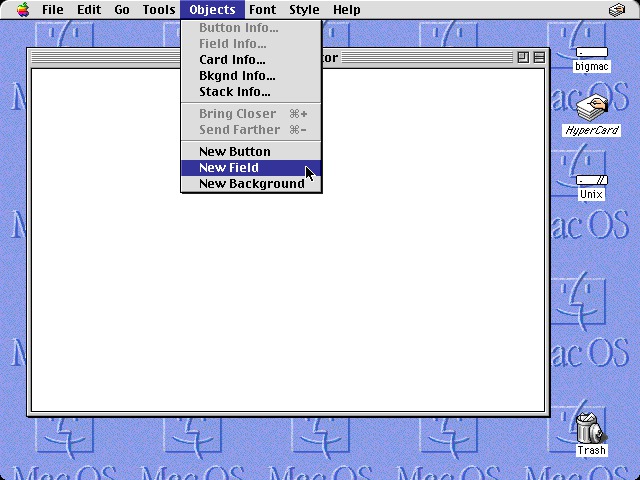
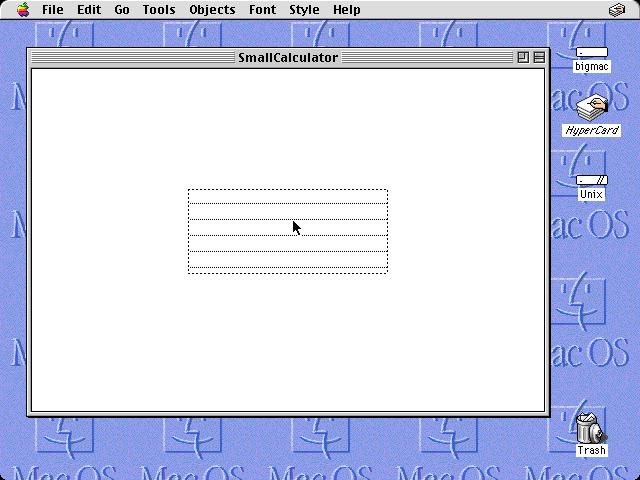
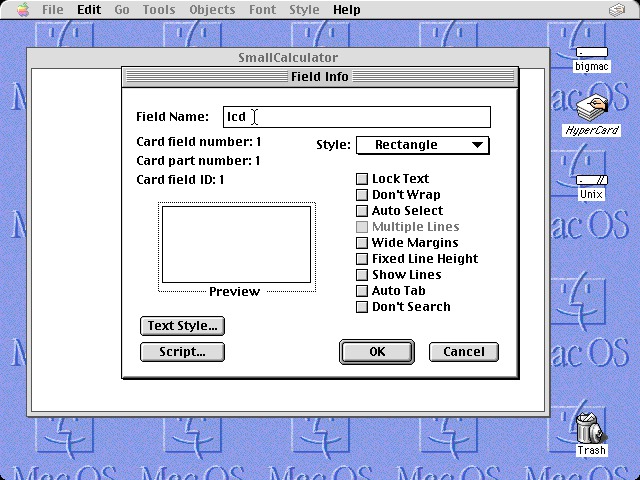
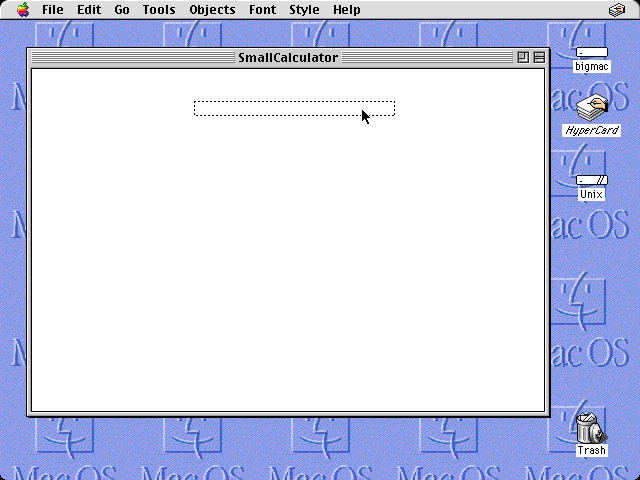
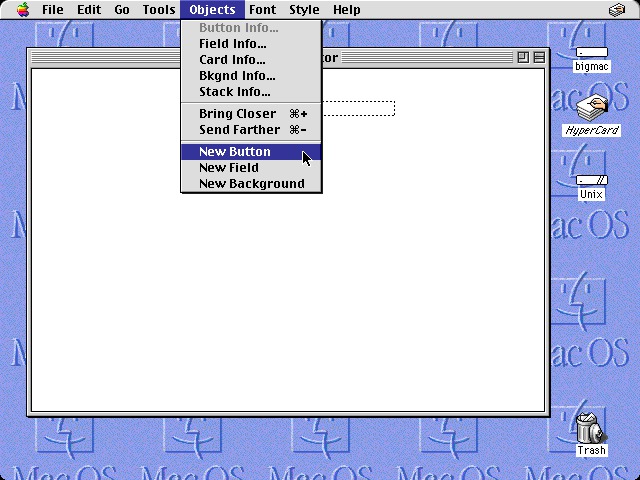
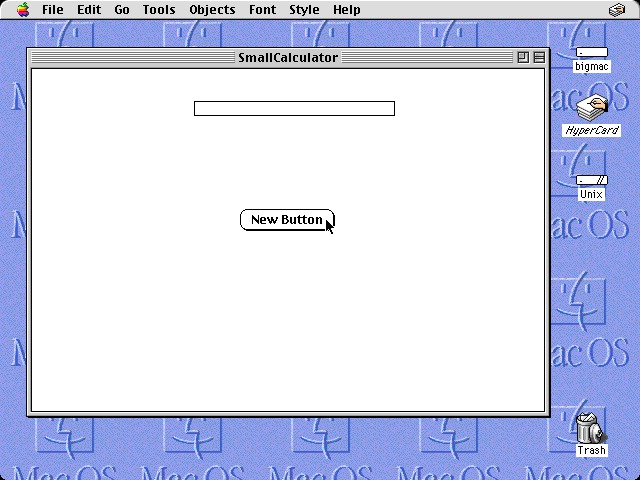
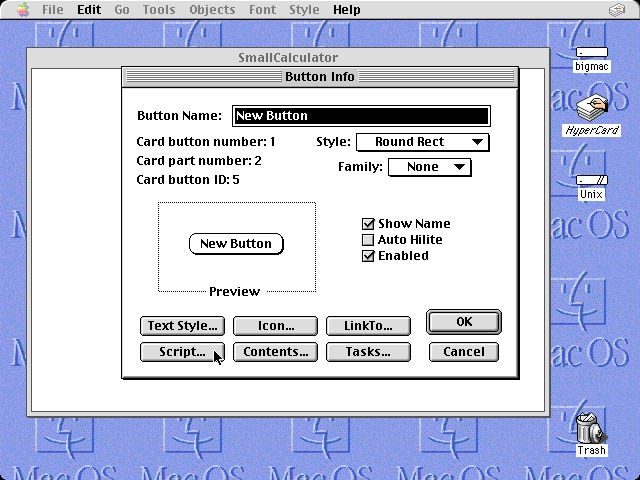
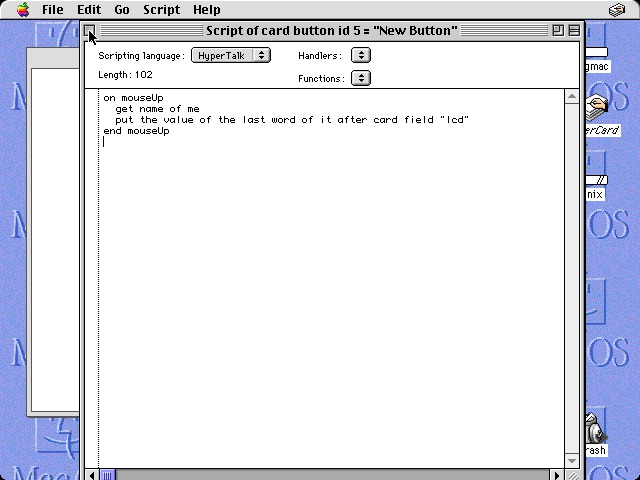
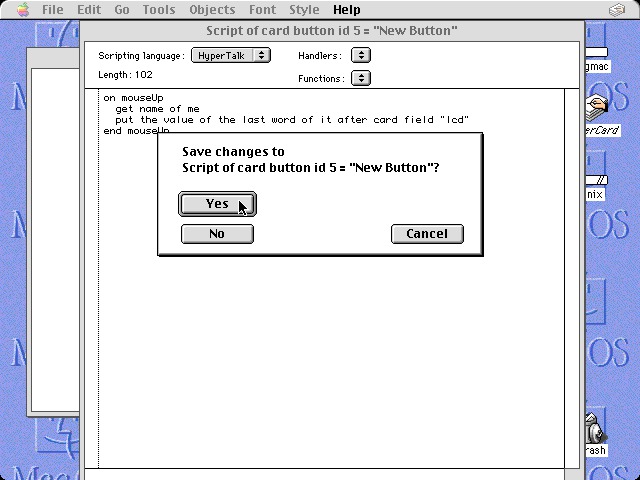
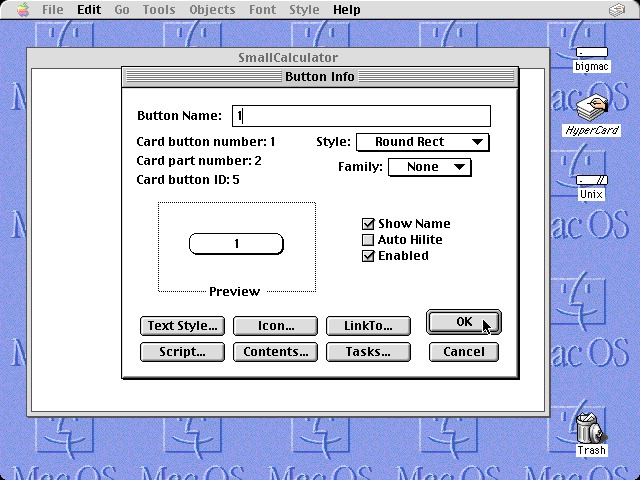
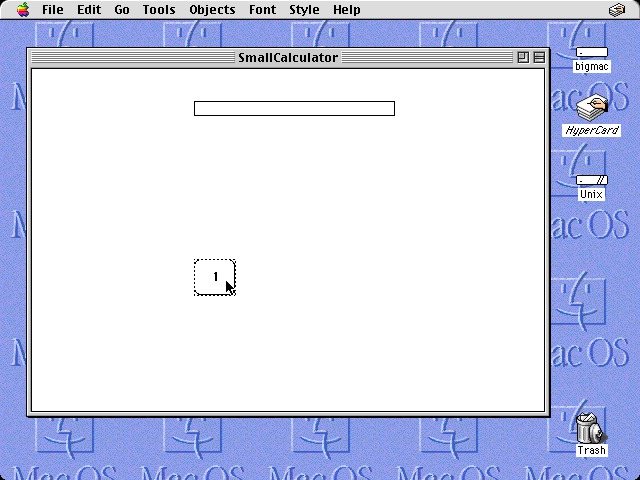
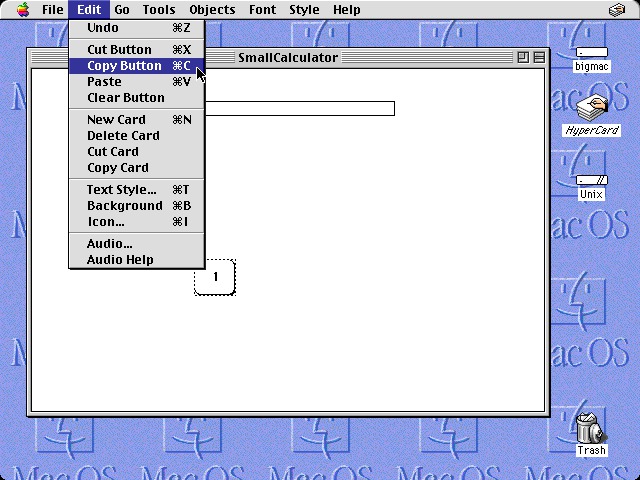
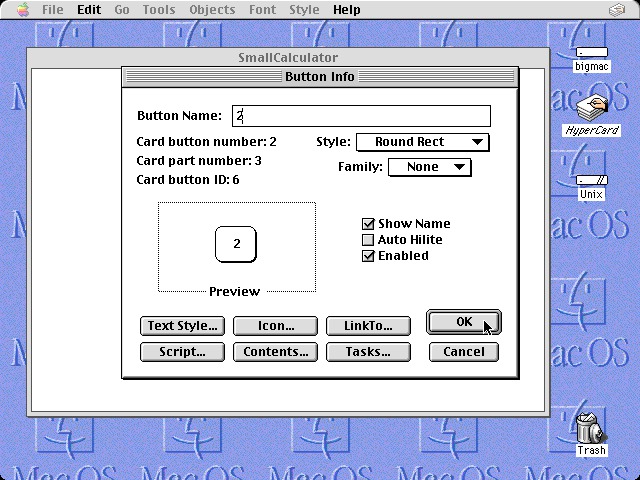
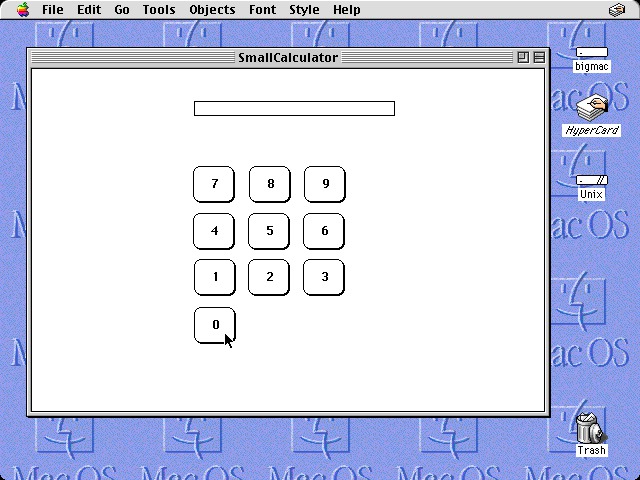
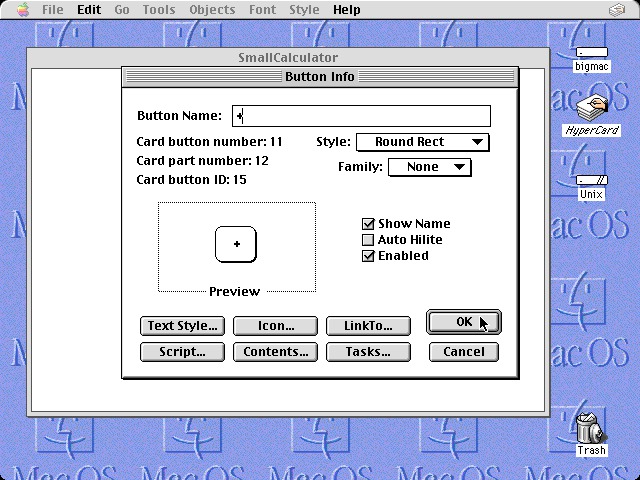
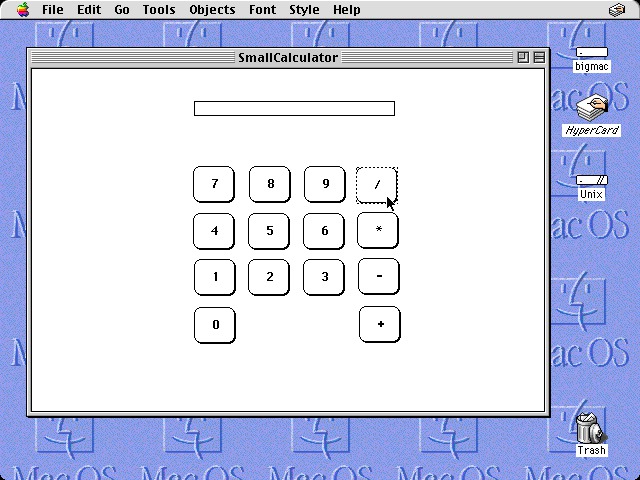
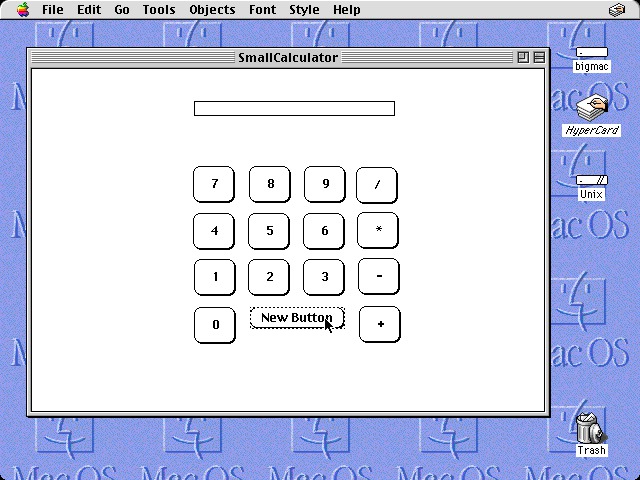
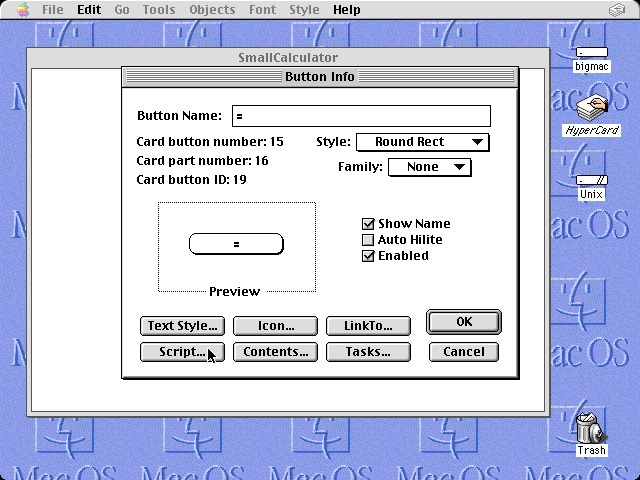
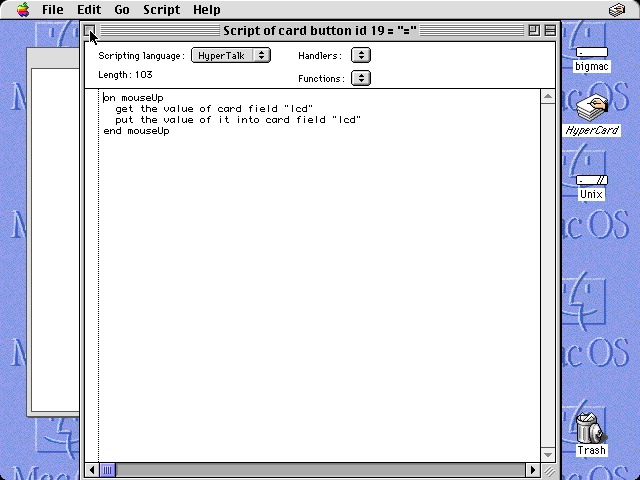
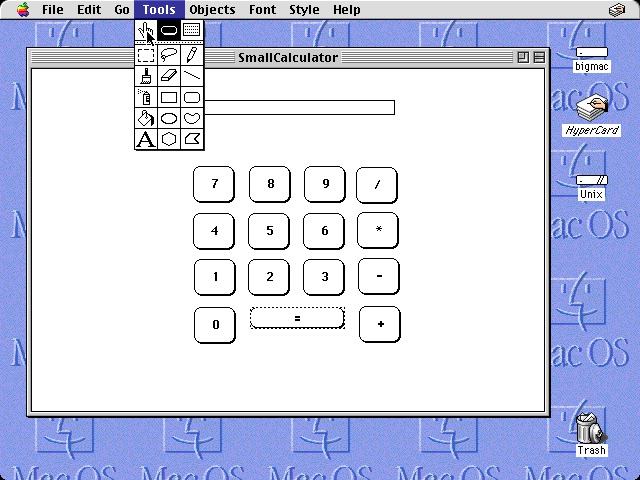
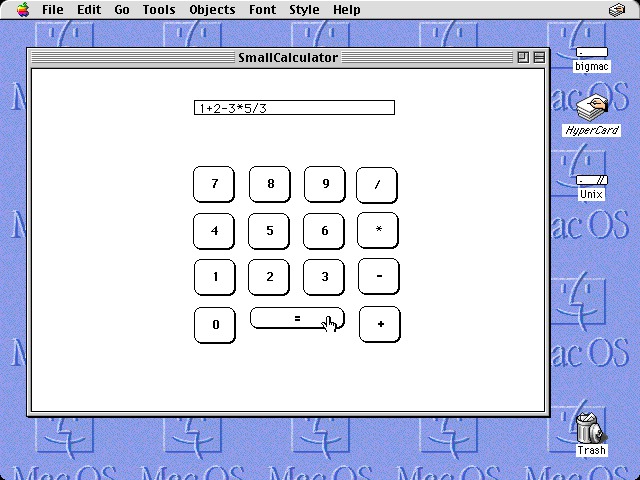
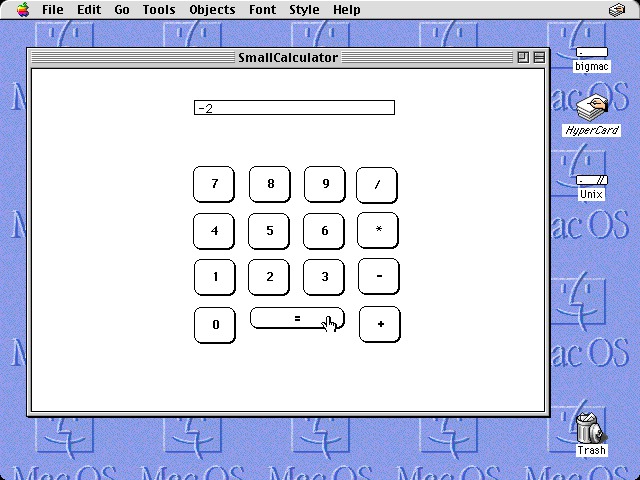
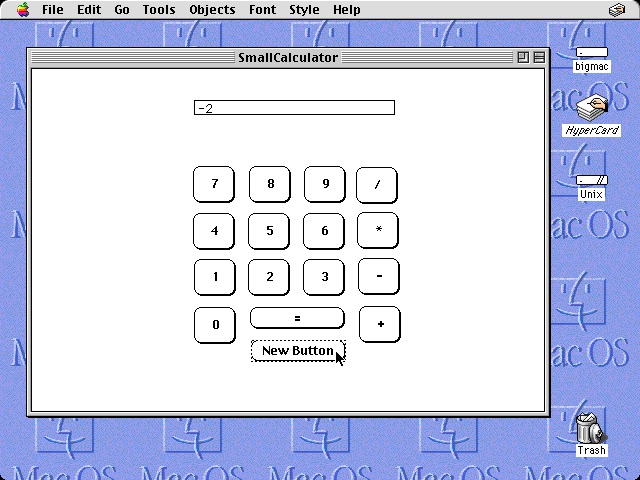
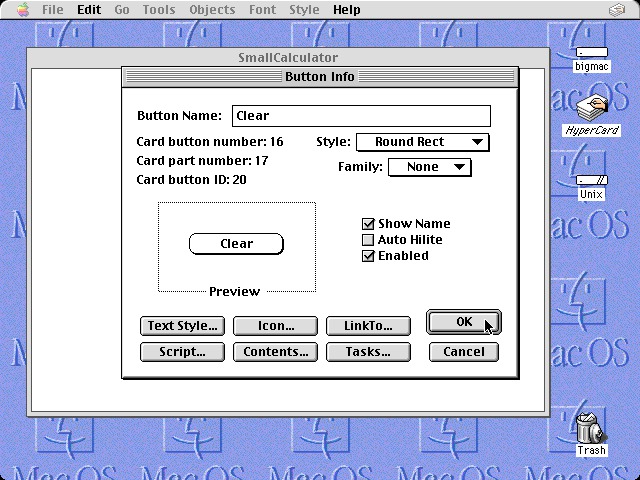
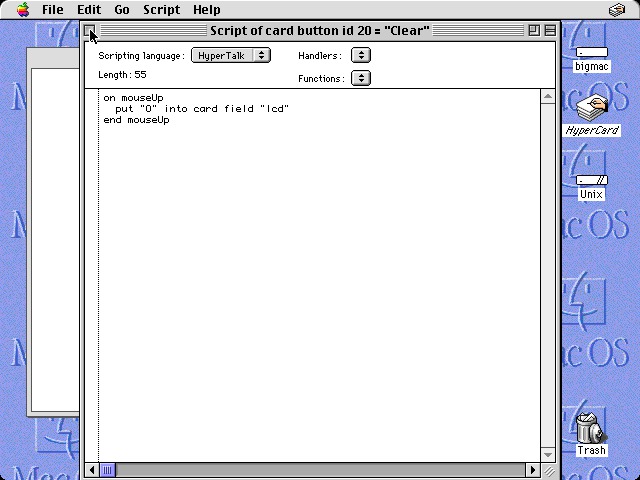
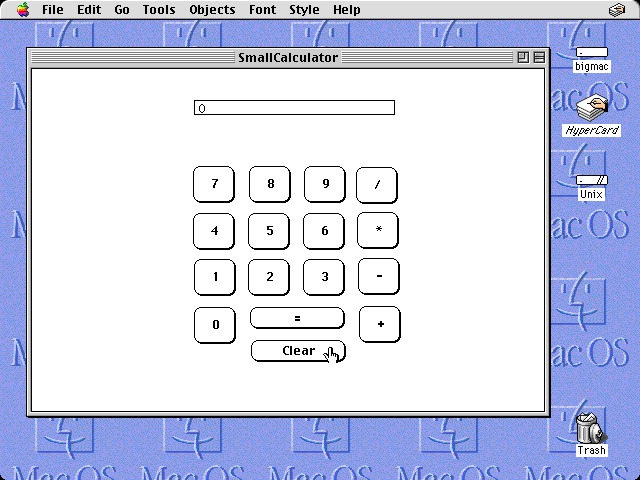


WoW, did a lot of people miss the point on this one.
. Hypercard was an easy to use, child friendly way of introducing programming to children and adults, in the same spirit as Logo, Pilot, Basic (which now kicks ass in the form of PureBasic ,not Visualbasic which has always been junk).
With a few mouse clicks you could make something that you could show off to your friends, and some people even used it to make some cool educational programs. Hell even some games were made using Hypercard.
And yes, Steve Jobs was a control freak, and Hypercard was a way for users to create their own programs, and that scared the hell outta him. Steve liked things that make him money, and there was no money in Hypercard, so he killed it.
And I also agree on the Java comment,
How this messed up backassward language ever got popular is beyond me. If you don't believe me, take Purebasic (free demo) and Java, try and make a simple text editor in each, hell Purebasic is its own text editor.
( and no I don't work for the guys that make Purebasic, just the closest thing to easy programming I know)
Java, well lets just say, it strong armed its self onto cell phones. A pity, Hypercard or basic would have been way more fun to play with.
Oh and before some one steps in and tries to tell me about programming, I've been doing it for 20 years and I know a few things, so don't even bother, unless you just want me to laugh.
Oh and Merry Christmas to all and to all a good nite! ho ho ho
In a very strange way, this Hypercard looks like what is available in Visual C++ to the current version of Visual Studio forms. Closely similar means of creating your window/form, except that you get your widgets or controls from a drop down menu instead of dragging from the toolbox pane. Also, the script looks a lot like COBOL (very wordy). You still need to know the scripting language, just like you would need to know BASIC or C++ to complete your programming. Now, Microsoft has LightSwitch, which is supposed to allow non-programmers to create business applications. It seems the more the world changes, the more it stays the same.
"... I’ve yet to find any tool that can match it for almost instantly prototyping complex ideas....'
A number of people have said this kind of thing. Look at LiveCode -- it's HC on steroids, and it runs on current platforms. (Note: I have no connection with LiveCode, just a happy user.) You don't have to keep an old mac running OS7 around.
One of the LiveCode and old HC mavens, Jacque Landman Gay, said on our mailing list that the reason Steve Jobs killed HC was that he didn't understand what it did, just thought it was only good for making rolodexes. (She heard the story from Kevin Calhoun after Kevin met with Jobs to try to save HC.)
If Steve could see this now: The NASA Mission Control software for the Landsat 7 satellite is written in Livecode (formerly known as Revolution):
From http://tinyurl.com/cf35nrr :
------
"We've built lots of Revolution applications that fill important needs" says Ivar [Ivar Tillotson, the Spacecraft Systems Engineer]. "One is a web application that lets us check on certain spacecraft activities while away from the office. Another is a real time display of where Landsat 7 is and which onboard commands it will execute next, along with other goodies like what time it will see the next tracking station and how close it is to running out of onboard commands. We started some of these applications as a pragmatic way to make some of our data more readable, then we started combining selected information from several files into one report. And then using the information to calculate new information snowballed like that. One of our Revolution applications has buttons for retrieving and processing the most current files from assorted directories on assorted computers, delivering the resulting files to different directories on different computer's transmitting some files out as email and printing others. The modules call each other to complete their own tasks. All the file manipulation is done to improve situational awareness by keeping the most current information together and easily accessible. And most of the actions happen automatically, based on timers or when products appear in a drop box."
We asked Ivar why NASA selected Revolution for this project. He explained how Revolution was particularly suited to doing the job. "Overall, the Revolution language is the key feature. Revolution is logical and intuitive, its easy to start small and build up features and capabilities and when things don't work right you are guided right to the problem. It's a high-level language with a low-level of frustration."
Ivar went on to tell us how the needs of the space center change regularly and how Revolution helps them to keep up. "We have to deal with changes on the spacecraft, changes with our ground equipment, new priorities in image collection, almost every aspect of running the mission can change and we still have to fulfill our goal – keep generating quality images of the Earth. Whenever I need to add a new module I just open up Revolution and add a new button. There's a good chance I have an existing component that can be quickly adapted to fit the new role. For example I have a bunch of utilities that do all sorts of little esoteric jobs, for example extracting 32-bit chunks of data from 8-bit words, converting non-contiguous ranges and converting them using an outdated Air Force floating point method, deriving timestamps for each entry and…it goes on like that. Rapid development is the key, because if it takes longer to write and test the code than just to slog through the task by hand, is it worth writing the code?"
Revolution has a number of outstanding features too. There are so many ways you can optimize your code to get tasks done. The URL functions are so easy to use. I replaced something that used to take 50 steps to download data in an older language with a single line "put URL into URL ". When I first discovered this I practically did a dance through the office."
------
Once again, the real value is that HC and its descendants allow intelligent non-IT professionals to design, build, and modify their own applications.
Isn't Adobe Flash, with it's Actionscript, a Hypercard of today? I remember using it in high school around 2001 in a very similar manner to yours.
Yeah, back when Flash was owned by Macromedia, it functioned very much like this. Put objects on canvas, set object type, add functionality to object (through code). Then Adobe took it and turned it into yet another proprietary object oriented language...
It's funny you should say that... since HyperCard's "HyperTalk" is just another proprietary object oriented language. I'm not sure that your words make the point that you intended them to.
Dear justapoint,
“HyperTalk” is just another proprietary object oriented language
And, Earth is just another planet.
But in all seriousness, HyperTalk wasn't at all exciting as a language. Just about any professional programmer will balk at its verbosity: "the damn thing looks like COBOL."
The key feature of Hypercard was the simplicity and explorability of the system as a whole.
Yours,
-Stanislav
The underlying structure of SVG documents is not that bad, but XML notation certainly is. This can be solved by embedding your SVG structure in Lisp with something like SXML:
(svg (@ (xmlns "http://www.w3.org/2000/svg")
(version "1.1"))
(circle (@ (cx "100")
(cy "50")
(r "50")
(stroke "black")
(stroke-width 2)
(fill "red"))))
As for JavaScript, as it is an Algol based language, you shouldn't go anywhere near it. It is also pretty inefficient so there are better means of interfacing with SVG like the Analemma Clojure library which uses Batik.
I was a huge fan of HyperCard back in its glory days, and wish it was still being developed, but some things to consider...
• When HyperCard was first released in 1987, Steve wasn't even at Apple; he was at NeXT. When he returned to Apple years later, HyperCard was already declining in popularity. (The big turning point in popularity was when HC was no longer free.)
• Steve correctly foresaw that the trend was away from the "do-it-yourself" programming of the early days. As computer use became mainstream, most users were no longer computer geeks; they were ordinary folks who had little interest in doing their own programming. For the small percentage who did, there were other commercial programs available like SuperCard (which I never liked as well as HC, but it was available and was more advanced than HC in some ways).
[...] #2: Why Hypercard Had to Die “Does anyone really believe that Mr. Jobs genuinely ‘thought you could do everything in [...]
Boxer from A. Di Sessa is an attempt to this computer as a medium approach, which goes with blurring the frontier between using and programming, with a similar "PITUI" approach (Programming In The User Interface) (http://dewey.soe.berkeley.edu/boxer/).
I disagree; I think that Steve and others in the industry chose to drive that trend. Had Jobs, Gates et al worked towards creating great user-programmable general purpose computers, the world would be a different (and better) place now.
Hello,
I have been trying to get on to the iHUG website (http://www.ihug.org/) but when I click on the link all I get is a blank page. Am I doing something wrong or is there a problem with the website?
If you know what is wrong or have a working link please email me at:
nigelferguson6@gmail.com
Thanks for all your help.
Apparently, there a is problem with the website.
I developed in Hypercard pretty extensively in the 90s. It was a great (and surprisingly powerful) language, but the idea that Jobs was responsible for the death of a product that hadn't had a major upgrade in *8 years* when he finally pulled the plug is ridiculous.
Thank you for your efforts resurecting a copy of Hypercard and creating this post.
Having used Hypercard and worked with SK8 and other dropped Apple projects allow me to put forth a left field notion.
The first malware I ever saw (and still the first I'm aware of existing) on Mac OS was a Hypercard stack. The widest openings taken advantage of by malware on MS Windows has been the category of foreign code execution (ex. Excel spreadsheets, MSWord documents containing code, ... .) iOS and the App Stores were designed with the idea of securing Apple devices against foreign code execution.
Apple is all about EASY usability. Malware besmirches the image of easy to use. Apple even advertised a bit about promoting the relative freedom from malware. This is a BIG selling point for Apple.
What if the decisions in question here were based on Apple's image? Would that be in line with the main thrust of Jobs' efforts? I think so.
So, would Jobs have understood the connection between freedom from malware and user generated code? Well iOS, the App Store, and the developer contract for iOS that explicitly prevents apps that execute foreign code from the App Store seem to indicate he did. (Forget conspiracies of this being specifically targeted at Adobe.) But what about way back at the point of canceling Hypercard? Jobs had really good technical advisers back then too, and by all indications he really trusted them on the technical stuff and used them. He made the image decisions though. (That lost him some good technical folks that ran up against some of his image decisions.)
As to the point of denying users the ability to program for Jobs pet devices, remember that when Jobs started NeXT he grabbed programming talent from Apple explicitly to produce an easy-to-develop-programs-in environment, NextStep. And it was delivered free on every machine they sold. In fact it was a major selling point of the NeXT cubes. That hardly seems anti programmer or keep-the-tools-away-from-the-kids repressive. The target audience wasn't home users though. It was universities,... and their students/researchers/professionals. This was an informed audience steeped in the sharing of code. No need for safety belts.
NextStep became Xcode and was again given away for free. What could be a really expensive programming toolset that cost quite a bit to develop was free, as in beer. But this gets people writing code on Apple machines *without much threat of malware!!!
Then we get to the notion that Apple users should be seen solely as consumers. There are a few answers for that: MacPaint, MacWrite, the LaserWriter, ..., GarageBand, iMovie, Keynote, ... Guessing that you get the picture, lets fill in a bit of back story. Jobs was a major proponent of empowering people with tools to engage and create. Just go look at some of his statements and the history of his pet projects. Jobs was all about promoting creativity and making it accessible, so long as it was safe.
So do I really think avoiding malware (already present with Hypercard and growing) was the only reason for canceling Hypercard? Certainly not.
Hypercard was an old code base (completely out of line with the NeXT OS and dev tools) that had the taint of being the product of a sans-Jobs Apple. (When NeXT took over Apple there was a purging of sorts.) The rewrite that would have been necessary would take programmers away from more critical tasks at a time when Apple was scrambling desperately to get OS X polished. The Hypercard project had already languished and didn't have the folks necessary for pulling it through the transition. While there were still folks using Hypercard, they didn't constitute enough of the buying public to warrant the effort at the time. The WWW was coming along though and much of the attitude at the time was that hyper-islands wouldn't survive.
So, as a CEO with a none too certain future what would you have done?
Dear Donald,
> So, as a CEO with a none too certain future what would you have done?
Very much the same thing.
Jobs acted quite logically, from the standpoint of increasing Apple shareholder value. But the rest of us lost out on a world with a Hypercard community in it. (A far more important thing than Hypercard itself. Hypercard could be re-created; the unique community which formed around it - rather unlikely.)
Yours,
-Stanislav
Woah woah woah, slow down there.
Let's simplify. How about: "A world where HTML exists."
Hypercard's main purpose was never to replace a system programming language, it was to create hypertext documents. Its inception pre-dated the World Wide Web's popularity, and by the time Steve got back, it was obsolete. He simply recognized a superior, more standard, more widely-used, better-adopted, more functional, better documented, and easier to distribute hypertext system and went all in. As he should have—he was absolutely right, as usual.
I don't get what's so difficult to understand here.
Occam's razor: it slices, it dices, it removes annoying superfluously complex explanations.
Dear Tristan,
Have you actually used Hypercard?
If not, please give it a try. I have made it as easy as it could possibly be.
Do you seriously think that the HTML/CSS/JS shit soup of the modern web browser is any kind of substitute for the jewel of simplicity that Hypercard was?
Do you remember your childhood, at all?
I pity any child who is shown a mess of Internet Exploder and pseudo-standard workarounds and hacks, and told: "this is programming."
Yours,
-Stanislav
I agree. Someone who thinks HyperCard's purpose was to create hypertext documents can't have seen it. Or even read your piece properly. Implementing hypertext was an accident. HyperCard was a full visual programming environment. Even with JQuery and JQueryUI these days I can't do half the things I could do effortlessly back then with HyperCard.
You're missing something big here.
The magic of Hypercard, as you describe it, is that you could, with an easy few clicks, create something that roughly worked and looked like the "big" applications you used all the time.
The applications today's kids use all the time are web apps.
Like it or not, but any modern Hypercard substitute will be web-based and create web sites, or otherwise completely miss the point.
FeepingCreature FTW! A 21st century "HyperCard" would definitely be web (that is, "HTM/CSS/JavaScript shit-soup") based. It would not be "no coding required", because that is and always has been a lie. It would have a library (possibly extensible, as HyperCard was, via XCMDs, although they were WAY too hard to install for most people) of user elements: buttons, fields, etc, each of which would support scripts. The elements would be intelligent: a button would know that it is a button and sport a sufficiently expressive, possibly extensible set of built-in methods (as ably shown in the article: "get the name of me", which could also be written "get my name" — gawd, I miss HyperCard). It would support multiple languages, as Hypercard eventually did with AppleScript belatedly joining HyperTalk. It would feature drag-and-drop positioning of elements, with or without a "grid". There would be no "IDE" within 1000 miles of it, because, like HyperCard, it IS the IDE. It would be easy enough for kids to make useful, interesting, fun, powerful things with it, but definitely not "dumbed down". It would NOT go the way of RunRev or SuperCard and try to be a full "application development environment", because both RunRev and SuperCard always sucked, sucked, sucked (and yes, I know that people have used both to create the most amazing thing that you, personally, have ever seen on a computer: I don't care — HyperCard was aggressively simple, they are assertively difficult).
That said, I think that there is zero chance that anyone will build this as a commercial endeavor, even though it is probably no more than the work of a year to do so. I would not be terribly surprised if something like this emerged from the open source world.
I love HyperCard, spent hours developing on it. But I disagree that Jobs killed it for the reasons you describe. I think that basically: a) hypercard never scaled beyond the simple uses it had it terms of both code and functionality, and b) was doomed by the many alternatives, particularly the web, that provided acceptable alternatives. Just its simple inability to support master controls doomed developers to cutting and pasting oodles of scripts, and the wild rise in the use of XFCNs and alternatives like SuperCard and Real Basic talk to its limitations as a platform. Yes, it was delightful and approachable in a way the alternatives never were, but for the people who needed delight and approachability, the web provided a cheap alternative that was "good enough", and for those who realized the limitations of the alternatives, HyperCard never rose to the level of a serious platform. Apple (probably not jobs directly) understood this, and made the right desicision from a shareholder perspective (as you point out).
To say that HyperCard and HyperTalk were ahead of their time and represented one of the first hypermedia systems the world ever saw is true. To take that and make the leap to it possibly being an inspiration for the world wide web is only possible if the word possibly is in 32 point bold font with subtext explaining it to being naught but complete speculation.
The sources given only go as far as to show the author of HyperCard stating that if he had grasped the potential of the Internet in it's design phase he could have created the first web browser. That's quite a far cry from the claim being made in the article.
That said, I'm not so sure the web would be in the state it is today if HyperCard had been the inspiration behind the World Wide Web. We might have been better off for it. 🙁
Well 'justapoint' I'm sorry to burst your bubble, but HyperCard definitely was one of the inspirations for the first browsers!
One of the very early browsers was ViolaWWW by Pei-Yuan Wei. This is the extended version of Viola, which in itself is a HyperCard clone for X-Windows (SUN Workstations) because Pei-Yuan Wei didn't have a Mac! Work on Viola started in 1990. After Pei-Yuan Wei became aware of the URL concept he extended Viola in one week(!) adding WorldWideWeb capabilities thereby turning Viola into ViolaWWW. This version was released in April 1992, which is clearly before the first release of Mosaic in January 1993! Mosaic itself was definitely inspired by ViolaWWW and Midas (another early browser) as these tools were studied for inspiration. The prominent back, forward and home buttons in the early Mosaic versions along with the history feature are definitely based on HyperCard.
Another WWW-idea that started with a HyperCard stack was the Wiki. Ward Cunningham writes that the first Wiki he created was some kind of knowledge management system while at Tektronix. That was the birth of the Wiki (1987-1989). The first Web Wiki was released in 1995.
So HyperCard did not introduce Web per se, but as one of the popular hypertext systems in the late 80's and early 90's certainly did inspire the development of the early browsers!
I spent a lot of time programming in HyperCard without realizing that I was really programming.
Only years later did I realise that concepts I learned in plain English were fundamental programming concepts which other people had learned in more terse, less visual ways.
And not only that, it was object-oriented, and it was modular, and those were transparent, self-evident things which didn't even need saying. Cards had fields and buttons. The cards and the scripts and the buttons had event handlers. Things in the foreground inherited and extended things in the background. You could "start using" another stack to take advantage of its functions. You could even get meta and write scripts which created new objects and wrote scripts for them.
It would be a great teaching tool even now.
All this talk of kids, hypercard replacements which don't cut it, etc. and no mention of Smalltalk/Squeak?
http://squeak.org/
Dear Tracy Reed,
Using Squeak is "like being drowned in Skittles." I understand that it is a monumentally great thing if one is able to see past that, but I suspect that most prospective users cannot do so.
Yours,
-Stanislav
We had a discussion about your analogy here: http://english.stackexchange.com/questions/55763/what-does-like-being-drowned-in-skittles-mean
Sorry to deflate your righteous indignation, but Hypercard was well into its decline before Steve Jobs got back to Apple.
There was a hypercard replacement on NeXTSTEP, called Hypersense, and the simple fact is that there wasn't enough interest in the product for the developer of Hypersense to even bother updating it for OS X.
-jcr
Dear John C. Randolph,
> Hypercard was well into its decline before Steve Jobs got back to Apple.
He could have opened the source and preserved the community and the goodwill.
> There was a hypercard replacement on NeXTSTEP...
NeXTSTEP euthanized the Mac, was renamed "Mac OS," and replaced it.
No NeXTSTEP app could have replaced Hypercard, at the very minimum for this reason.
Yours,
-Stanislav
reminded me of Android app inventor
Did people catch Mr Schiller's use of the phrase "a modern day HyperCard" describing the new iBooks Author(ing) software. That's particularly sanguine for me since I've used that exact phrase a number of times in letters to the Keynote development team asking them to beef up Keynote to allow for non-linear presentations/kiosks. That would require the addition of some kind of scripting facility and programming hooks into the Keynote document and the Application methods. Or at the very least some kind of logic control and more abstract links than explicit slide numbers, (like some GoSub/Return transitions).
Anyhow my chief request was to allow for the intergration of Quartz Compositions. Currently KN will play .qtz files but precludes any kind of user interaction via Apple Events and any kind binding to Keynote Slides/Objects/Methods.
I think QC is the closest thing Apple has to HyperCard as a visual programming application which, using 3rd party Kineme application Quartz Builder, one can generate compiled OS X apps. The server limitation is that QC is really just a framework and has poor UI architecture and really needs to be bound to Interface Builder objects in Xcode to make a satisfactory application. So it's no HyperCard but it is most definitely a powerful and fun introduction to coding.
If you think it is obvious that the Hypercard alternatives are all inadequate, then you should have no problem writing another post which explains how they are inadequate. I would be curious to read it.
Dear Frank,
Start by reading the edits and corrections after the article. And, of course, this. The alternatives will never add up to the original Hypercard community.
Yours,
-Stanislav
I'm using super-easy-to-write middleware Corona to create iOS apps. Apple approves my apps, and doesn't seem to oppose Corona. In fact, 14-year old kid, with the help of his mother doing level design, programmed a game using Corona that had over a million downloads. So, perhaps this is an interesting fact to reevaluate what Apple and Jobs' motives might be.
Far be it from me to criticize your posting strategy, but isn't alienating exactly the set of people who could actually write the thing, kind of .. counterproductive?
Dear FeepingCreature,
but isn’t alienating exactly the set of people who could actually write the thing, kind of .. counterproductive?
You are clearly new here.
Yours,
-Stanislav
I was with you... until the bout of name calling in the second to last paragraph. That was unprofessional, and your blog post would be better without it.
According to Steve Jobs biography, he didn't really care for Hypercard because the software people wrote with it looked like crap. Bill Atkinson, the creator of Hypercard, threatened to leave Apple if Hypercard was not included with each Mac. That was the ONLY reason that Steve Jobs went along with it.
Personally, I think Hypercard was a good way for people to start learning programming. But today there are other choices such as our product, Real Studio.
I'd like to believe your premise. But I don't.
Not that I think Jobs wouldn't have killed it for just such a reason, if he had any reason to fear Hypercard; He had no desire to see Apple as anything other than as a shiny non-end-user-programmable home appliance.
There are no fewer than a dozen clones of HyperCard. You say that they are not HyperCard, because they are too complex. Well, there's your answer then. You can't resurrect HyperCard, and you can't stand in the same river twice, because that river has moved on down the stream.
A modern hypercard would have network and web capabilities. A modern hypercard would have to run in the browser, or in the cloud. It would have to do a million and one things that don't fit on 880K floppy disks.
And so we have a more complex world than we had then.
There are a million options, from Squeak+EToys, to hypercard wannabes, to easy-IDEs-with-simple-syntax.
Hypercard syntax makes me want to puke. It's just like applescript, and it sucks. I can't imagine teaching it to myself, let alone to a room full of 8 year old kids. I taught my then- 8- year- old son Python, and he later taught himself C#, Delphi, Java and JavaScript, and some other stuff. He's probably a geek in the making, like his dad.
There is NO language in the world I could teach to my other son that he would care to learn, that was any more complex than playing a video game. He loves to play video games, and does not want to learn any language, not hypercard, not smalltalk, not python, not anything.
That's what Jobs knew; There are 999 people who will pay $1 for angry birds that won't spend ANY time learning to code for every 1 guy who will sit down and focus on a computer for anything like the time it takes to make something interesting, like even a calculator, in anything like hypercard.
I remember CA-Realizer was like a "hypercard" for me, when I was new to windows development, it took the edge off the complexity, and didn't require you to read giant tomes of horrid technobabble. Realizer is dead now. So is Hypertalk.
They died because they needed to die because the world that needed them is now gone.
W
Warren P. says:
No, I think the point was that they are not HyperCard precisely because there are a dozen of them.
That dilutes the user community; in stead of one community big enough to survive, you get a dozen, each too small to survive.
I like you're observation...
I think this about the same reason, but in a different playing field, why Smalltalk lost to the C++/Java selling people... it is easier to control people dependent on a tool and sell them new features than work with people knowing that they can change anything and in any way in the system... especially if they learnt the concept at school.... the result is some (I'm being optimistic here!) C++/Java coders who can't write a shell/batch script to make a backup of their profile dir (really optimistic!)...
And as a side-effect no one notices this!
it is economically more sound to serve people fried fish for their cash, then charge them for salt bread, and in a year replace the white plate for a black one and charge extra and tell everyone that cooking is a really complicated matter that only a real pro can do (and charge the pros for it too – AppStore license), than to teach everyone how to simply fish and cook for themselves...
and you get the benefit of getting a group of followers, each one of whom will fanatically explain to everyone that it is impossible to make good food at home 😉
A die hard Hyper Card fan here, and I think most people are missing the "extreme simplicity" argument that you put forth. All of the "pretenders to the throne" as it were totally missed the point of HyperCard and added way too much complexity. Thanks for providing the link to the actual downloads, I have it installed and running after so many years! cheers
check this out, its no hyper card but worth a look.
http://en.wikipedia.org/wiki/WarioWare_D.I.Y.
Steve did not kill HyperCard. It was dead long before that. Scully killed it when it was transferred to Claris and they started charging for it. Before that it was part of the Mac so it was incredible. Steve just finished it off officially but bad decisions and years of neglect were what really killed it. Steve may not have been a fan but he was only the final stop on the way to oblivion. I miss it to. I worked on a version of HyperCard at Apple in the early 90s. Full color native port for Apple IIgs!! It was rad.
No NeXTSTEP app could have replaced Hypercard,
I saw Hypersense, I used it, and it did indeed replace Hypercard. As I recall, it could even import Hypercard stacks.
Hypercard died out from lack of interest. Go cope.
-jcr
Dear John C. Randolph,
> I saw Hypersense, I used it, and it did indeed replace Hypercard.
The idea that a NextStep app "replaced Hypercard" is sheer nonsense.
You may own a Next box, but how many "civilians" did?
> Hypercard died out from lack of interest.
Did the tens-of-thousands-strong "save Hypercard" petition look like "lack of interest" to you?
And how about the ~50,000+ page views (to date) of this article?
Yours,
-Stanislav
Hey, if you're so convinced there's a market for it, you can probably buy the source to HyperSense. It's written in an older version of Objective-C, but you should still be able to compile it on OS X.
Good luck, but I wouldn't risk any of my retirement savings on your chances.
-jcr
Dear John C. Randolph,
You are almost certainly right: few would buy it today.
The era when people were willing to pay for programming environments may be gone forever at this point.
Yours,
-Stanislav
[...] and learning more about the systems they use every day. I want it to serve a similar purpose as Hypercard did back in its day by easing people into an unfamiliar new territory. I really, really hope it [...]
I was around when all this was happening. Regardless of how many sales you are personally aware of, I sold almost no copies of SuperCard. My boss was a big fan of and sold several copies of Hyperstudio which basically smoother out the rough edges while using those extensions. I just checked and it's still around here http://www.mackiev.com/hyperstudio/index.html
Surprised to see no mention of that one or the successors Director, which spawned from VideoWorks, Authorware, and mTropolis- a rare beast used to make Muppet Treasure Island.
Final thoughts are: FileMaker. You can do a lot of hypertext-style stuff with that. Cards are called "Layouts", and you can import a graphic and turn it into a button which runs scripts.
P.S if you're having fun with vintage stuff, try "World Builder".
Why can’t I get a confirmation that my post has been submitted and will be moderated and may appear on the site?
I first learned programming in Pascal, dBase, Forth, Savy, etc.
Then Hypercard came along.
Love at first sight.
For so many of us, it was like our first «bicycle».
We discovered the liberty of movement,
the speed, the fun to go everywhere with our friends.
Sure, later on, we got motorbikes, cars, trucks...
We can't go back in time, but as far as I'm concerned,
even if it got killed too soon,
the role Hypercard played in the history of computing is forever.
This is probably the best article I've read on the internet. I spent years making things in hyperCard as a kid, and you perfectly nailed the feeling of wonder, discovery, and creative empowerment that the software provided, despite only spending a fraction of the time with it.
I am also 100% in agreement with your rebuttals regarding HyperCard alternatives - they are not the same. There's no two ways about it. Those programs (and the commenters here that are suggesting them or even other programming languages) are completely missing the point.
I love technology and I am always thrilled to see things advance and improve, but damned if I don't wish I could just go back in time to 1993, hurrying home after school to work on another interactive adventure without even having to think about it. I could simply create.
I think you're absolutely right. Future historians will agree with you!
[...] Loper OS » Why Hypercard Had to Die I was a Hypercard child – though our friendship was brief. Our seventh-grade class was led into a room full of brand-new Macintosh Performas. The day's lesson was a crash course in the use of an u… [...]
What about MIT's scratch?
Dear Riley,
Scratch is certainly interesting. But it is no Hypercard. The latter was not geared specifically for children, and produced “adult”-looking (if imperfectly Mac-compliant) apps.
Yours,
-Stanislav
I was a HyperCard fan ... but didn't have a Mac. So I used two alternatives that had the HyperCard 'feel' (and almost the same syntax as xTalk):
- HyperPad was a DOS program (no graphic mode) that was very good - the syntax was a cross between Pascal and xTalk.
- WinPlus 3.0 - a very good HyperCard clone: you could import HyperCard stacks and there were many additional commands for using bitmaps. Like most of the HyperCard clones, it disappeared (was bought by Oracle I think and changed to Oracle Media Objects and then it also went away!)
Even TileStack disappeared (and the source code is nowhere to be found). It was a decent web version of HyperCard.
If only some of these programs were released ...
(forgot the old ToolBook for Windows - still exists but is really expensive!)
'Complexity' is a misleading word for one of the great sins or blasphemies of design. Complexity isn't complexity in computing. Complexity in a programme or a language is not complex in the sense that it is *hard* to understand. If it were merely hard the effort expended would be rewarded by an increase in mental acuity. Complexity in software would really be better called *cacophony* -- the musical term to my mind perfectly reflects that sense of *stupefying impenetrability* that cruft-ridden software or a badly designed language engenders. The so-called 'complexity' of these cruft-artefacts is really cacophony, signal-drowned-by-noise, masquerading as power or flexibility. The beauty of HyperCard or the 8-bit personal computers wasn't in their purity or expressiveness in the Paul Graham sense, but rather their *knowability*. They verily *invited* you to peel back their secrets because, even though they had their frustrating quirks and limitations, they were not so complex and bloated that they resisted patient experimentation.
To my mind what is desirable is not the much debased word 'simplicity' -- used by marketers to sell finger-painting-level touchscreen gewgaws to the masses -- but terms like clarity, elegance, efficiency, or even plasticity. A beautiful computer language should be one that, like clay, has enough substance to be manipulated but enough give to invite fantasy and improvisation.
PS: Why are we inflicted with the abomination of CAPTCHA when a simple thumbprint-scanner built into keyboards universally would solve 99% of authentication problems for most users. I have literally resubmitted this post six times. It's depressing to think that this is the best 2012 has to offer!
Dear Iian,
I agree with everything you said with the exception of the last paragraph. Biometric authentication inherently sucks. Even ignoring the low quality of consumer biometric sensors (thumbprint scanners, etc) - when someone intercepts a password going over the wire (say, using a locally-installed keylogger) - you can create a new password. But where will you get a new thumb when your thumbprint is recorded? It only needs to happen once. The entire concept is a malicious scam by the Insecurity Industry.
Yours,
-Stanislav
As a late commet to all this, I'd like to bring up a tool that I enjoyed for years during its existence on classic Mac OS. That tool was FaceSpan and was basically a UI-Environment for AppleScript. Both together provided something that I would see as the logical next step to HyperCard.
Together they provided what typical programming languages lack (except for the Visual stuff on Windows): Object-Grabbability (and therefor persistent existence of those objects): The visual representation of objects inside your project. There are just enough people with a more visual oriented construction style who need a workbench on which they can place their stuff, sort it, improve and refine it an make the whole bunch talk to each other. Without giving each a name, putting it in a file that then shows up in a plain sequential list on the left side of the project. The idea of "project" alone is a pain to think about in this context. It's a working structure that you build, that has an interface to the world, a black box (actually more a glued-blocks-structure) build out of objects, more mechanic than "coded". If you can leave "Coding" and "Project" and any synonym out of the tool approach, you might be on the right way to understand why Hypercard was useful and fascinating.
-Stefan
I cannot agree more with your analysis about hypercard as an empowerment paradigm; and that being exactly why it was killed, with the emerging locked-dumbed-down-walled-garden-closed ecosystems approach, by steve jobs, but also a common trend (facebook, google, etc.).
Steve Jobs-alike industry want consumers drone-trained, locked and dependent. They drive and enforce this trend, while claiming to follow a mass consumer trend; it is the very similar argument of the lousy cheap manipulative and brainwashing TV programs for the masses claiming they do it because that is what the masses want.
Hypercard was an incredible empowering tool, that put personal computers at the service of their users, both techies and non-programmers, and that encouraged increasing knowledge and skillful use of its power. Current ICT is less and less transparent, on purpose, and deal with consumers like predators deal with their prey. They want to command and control consumer tastes and ways of using devices, not facilitate user choice and empowerment. They want to transform each person into a locked consumer, not a free citizen with choice.
You are also, unfortunately, absolutely right about the hypercard follow-ups. The best I know, Livecode, just DONT GET IT. They think as geeks doing tools for developers, with a frenze of new features each version, designed to produce "standalones" for the consumers, instead of building a solid environment with a good , stable core of features and an easy learning curve, where each user can be also a develpper and vice-versa. I would exchange happily 2/3 of the miriad of features for such a consolidated, wide-spread environment, that could rebuild a community, like you very correctly pointed out, was the major strenght of hypercard. In a way, the hypercard vibrant and enthusiastic community, exchanging and sharing stacks, with open code, pre-dated much of the best of the open-source spirit community.
I hope people dont give up fighting this perverse trend. We can change this. There are more and more people aware of the manipulative tactics of the industry, and reacting against it.
Dear Pedro,
> There are more and more people aware of the manipulative tactics of the industry, and reacting against it.
Who, exactly? I see no credible push-back anywhere.
Yours,
-Stanislav
[...] year, and it prompted our own Steve Sande to reminisce about his experience with HyperCard as well. Speculation about why HyperCard was left to wither and die is also out there, as is a brief chat with creator Bill Atkinson about his feelings towards his [...]
[...] year, and it prompted our own Steve Sande to reminisce about his experience with HyperCard as well. Speculation about why HyperCard was left to wither and die is also out there, as is a brief chat with creator Bill Atkinson about his feelings towards his [...]
[...] year, and it prompted our own Steve Sande to reminisce about his experience with HyperCard as well. Speculation about why HyperCard was left to wither and die is also out there, as is a brief chat with creator Bill Atkinson about his feelings towards his [...]